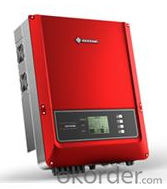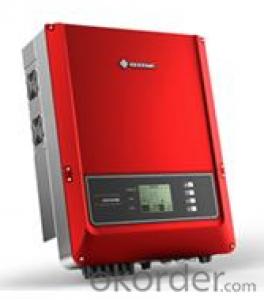Solar Inverter Off Grid Type Solo-10000S
- Loading Port:
- Shanghai
- Payment Terms:
- TT OR LC
- Min Order Qty:
- 10 unit
- Supply Capability:
- 1000 unit/month
OKorder Service Pledge
OKorder Financial Service
You Might Also Like
Product Description:
This system can keep 10 energy-saving bulbs with 15W working for 5 hours per day and a 5W radio working for 8 hours a day. The AC load can keep a 33in color TV (90W) working for 5 hours, a 70W phonograph record machine working for 5 hours, a 200L fridge (180W) working for a whole day, a fan less than 60W running for 5 hours, a 300W computer working for 4 hours, two 100W laptops working for 5 hours, a 1000W water heater running for 1 hours, a 2000W electric stove working for 2 hours, and another 1000W appliance running for 3 hours.
It can work for 3 successive rainy days.
● System voltage:220V
● Output:220VAC/50Hz
● Power: 11000VA
● Dimensions of the box: 600 X 2000 X 600mm
● Net weight: 400kg
Product Datasheet:
Main Accessories | Specifications | No. | Notes |
Inverter | Solo-10000 | 1 | Standard |
PV modules | Polysilicon 100Wp | 68 pieces | Optional |
Storage battery | Lead acid, maintenance-free,2V/400Ah | 110 pieces | Optional |
Controller | Solo-VS220V/50A | 1 unit | Optional |
PV accessories shelf | customized | 1 set | Optional |

Product Advantages:
Powered by DC current
Can used out of doors
High effiency and low noise
FAQ
What is your payment terms?
We accept T/T payment, normally we need 20% T/T in advance, 80% payed before shipment.
What is your packing system?
We put the sistem in the wooden box.
Can you do OEM service?
Yes we can, but we need to do it with a certain order quantity.
- Q:Can a solar inverter be used with a solar-powered remote monitoring system?
- Yes, a solar inverter can be used with a solar-powered remote monitoring system. The solar inverter is responsible for converting the direct current (DC) generated by the solar panels into alternating current (AC) that can be used to power various devices, including the remote monitoring system. This allows the remote monitoring system to be powered by the solar panels and ensures that it operates efficiently.
- Q:Can a solar inverter be used with solar-powered water heaters?
- No, a solar inverter cannot be used with solar-powered water heaters as they operate on different principles. Solar inverters are designed to convert the direct current (DC) generated by solar panels into alternating current (AC) for use in residential or commercial electrical systems. On the other hand, solar-powered water heaters use sunlight directly to heat water, without the need for converting DC to AC. Therefore, these two systems are not compatible with each other.
- Q:Can a solar inverter be used with a solar-powered electric fence system?
- Yes, a solar inverter can be used with a solar-powered electric fence system. The solar inverter is responsible for converting the DC (direct current) power generated by the solar panels into AC (alternating current) power, which can be used to power the electric fence system. This ensures that the solar-powered electric fence system can operate efficiently and effectively, utilizing the energy harnessed from the sun.
- Q:What is the purpose of a solar inverter in a solar power system?
- The purpose of a solar inverter in a solar power system is to convert the direct current (DC) electricity produced by the solar panels into alternating current (AC) electricity that can be used to power electrical devices in homes and businesses.
- Q:Can a solar inverter be used with different types of backup power sources?
- Yes, a solar inverter can be used with different types of backup power sources. Solar inverters are designed to convert the direct current (DC) generated by solar panels into alternating current (AC) that can be used to power electrical devices. They can be integrated with various backup power sources such as batteries, generators, or the grid. This flexibility allows for a reliable and uninterrupted power supply, utilizing solar energy as the primary source while seamlessly switching to alternative power sources when needed.
- Q:Can a solar inverter be connected to a computer or smartphone?
- Yes, a solar inverter can be connected to a computer or smartphone. Many modern solar inverters come with built-in Wi-Fi or Bluetooth connectivity, allowing users to monitor and control their solar energy system through dedicated apps or web portals on their computers or smartphones. This enables real-time monitoring of energy production, system performance, and even allows for remote troubleshooting and adjustments.
- Q:What is the role of a cooling system in a solar inverter?
- The role of a cooling system in a solar inverter is to regulate and dissipate heat generated during the conversion of DC power from solar panels to AC power for use in homes or businesses. By maintaining optimal operating temperatures, the cooling system ensures the inverter's components do not overheat, which could lead to reduced efficiency, performance degradation, or even system failure.
- Q:Can a solar inverter be used with a solar-powered greenhouse system?
- Yes, a solar inverter can be used with a solar-powered greenhouse system. A solar inverter is necessary to convert the direct current (DC) electricity generated by the solar panels into alternating current (AC) electricity that can be used to power the various components of a greenhouse system, such as fans, lighting, and irrigation systems.
- Q:Can a solar inverter be used in a mobile or portable solar system?
- Yes, a solar inverter can be used in a mobile or portable solar system. Portable solar systems typically consist of solar panels, a battery, and an inverter. The solar panels generate electricity from the sun, which is stored in the battery. The inverter then converts the stored DC power from the battery into AC power that can be used to power various devices and appliances. This allows for the utilization of solar energy even in remote or mobile settings.
- Q:What are the potential risks of overvoltage in a solar inverter?
- The potential risks of overvoltage in a solar inverter include damage to the inverter itself, as well as other connected equipment such as solar panels and batteries. It can also lead to electrical fires or pose a safety hazard to individuals working with or near the system. Additionally, overvoltage can result in a loss of energy production and potential financial losses for the system owner. Regular monitoring and proper voltage regulation are essential to mitigate these risks.
1. Manufacturer Overview |
|
|---|---|
| Location | |
| Year Established | |
| Annual Output Value | |
| Main Markets | |
| Company Certifications | |
2. Manufacturer Certificates |
|
|---|---|
| a) Certification Name | |
| Range | |
| Reference | |
| Validity Period | |
3. Manufacturer Capability |
|
|---|---|
| a)Trade Capacity | |
| Nearest Port | |
| Export Percentage | |
| No.of Employees in Trade Department | |
| Language Spoken: | |
| b)Factory Information | |
| Factory Size: | |
| No. of Production Lines | |
| Contract Manufacturing | |
| Product Price Range | |
Send your message to us
Solar Inverter Off Grid Type Solo-10000S
- Loading Port:
- Shanghai
- Payment Terms:
- TT OR LC
- Min Order Qty:
- 10 unit
- Supply Capability:
- 1000 unit/month
OKorder Service Pledge
OKorder Financial Service
Similar products
New products
Hot products
Hot Searches
Related keywords






























